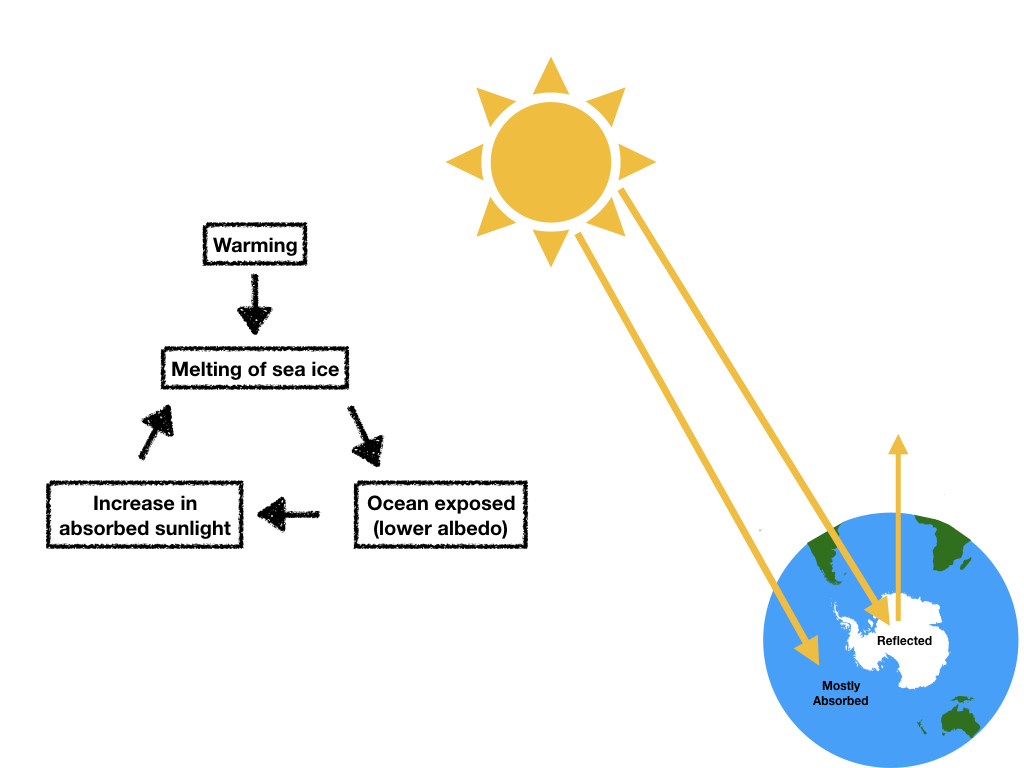Environmental systems are a complex network of interactions and relationships that exist within the natural world. These systems are composed of various components and processes that work in unison to maintain ecological balance and functionality.
What is a System in Environmental Science?
A system in environmental science is a set of interconnected components organised to achieve one or more particular purposes. These components can be physical, biological, or chemical elements, and they are characterised by their structure, which includes inputs, processes, outputs, and feedback loops.

A concise systems diagram showing inputs transformed by a process into outputs, with a feedback pathway that can regulate subsequent inputs. Use this as a visual key for the components named in the text. Source.
Inputs
Inputs are the initial elements that are introduced into a system. They can be in the form of energy, matter, or information necessary for the functioning of the system.
Energy Inputs: These are primarily derived from the sun, driving essential processes like photosynthesis in plants. The absorption of sunlight enables plants to convert light energy into chemical energy, initiating a series of ecological interactions.
Matter Inputs: These include essential elements and compounds like carbon, nitrogen, and water. They are integral in biochemical cycles, supporting life and various ecological functions.
Information Inputs: Environmental cues and signals, such as temperature changes or predator presence, influence the behaviour and adaptations of organisms within the system.
Processes
Processes are the internal operations that transform inputs into outputs. They are dynamic and multifaceted, involving physical, chemical, or biological reactions.
Physical Processes: These include natural phenomena like erosion and sedimentation, which alter the landscape and create diverse habitats.
Chemical Processes: These encompass reactions like photosynthesis and respiration, driving energy flow and nutrient cycling in ecosystems.
Biological Processes: These involve the life activities of organisms, including feeding, growth, reproduction, and death, which contribute to ecological diversity and complexity.
Outputs
Outputs are the end products or results that emerge from the system’s internal processes. They exit the system and can influence other systems or the broader environment.
Energy Outputs: Energy is often released into the surrounding environment in the form of heat or light, contributing to other systems or dissipating into the atmosphere.
Matter Outputs: These include substances or materials like oxygen produced by plants or waste products from animal metabolism, which can be inputs for other systems.
Information Outputs: Data or signals that indicate changes within the system, influencing the adaptations and responses of organisms and surrounding systems.
Feedback Loops
Feedback loops are mechanisms that regulate the system. They are essential for maintaining stability, as they enhance or inhibit processes based on the system’s outputs.
Positive Feedback: This type amplifies changes, leading to exponential growth or decline and often destabilising the system. For example, the melting of ice reduces the Earth’s albedo, leading to increased heat absorption and further warming.

Schematic of the ice–albedo positive feedback: loss of reflective ice decreases albedo, increases solar absorption, and accelerates warming. Use alongside the text’s example to show the reinforcing nature of positive feedbacks. Source.
Negative Feedback: This type counteracts changes, promoting stability. For instance, as CO2 levels rise, plant growth can increase, absorbing more CO2 and reducing its atmospheric concentration.
Detailed Examination of Environmental Systems
To delve deeper, it’s essential to explore specific examples of environmental systems, illustrating the intricate interplay of inputs, processes, outputs, and feedback loops.
The Water Cycle
Inputs
Energy: The sun’s energy is fundamental, driving the evaporation of water from surfaces like oceans, lakes, and rivers.
Matter: Water in liquid form serves as a primary input, setting the stage for the cycle’s various processes.
Processes
Evaporation: Solar energy transforms liquid water into vapour, which ascends into the atmosphere.
Condensation: As the water vapour cools, it condenses to form clouds.
Precipitation: When the clouds reach saturation, water is released as rain, snow, or other forms, returning to the Earth’s surface.
Outputs
Energy: Heat is released during condensation, contributing to atmospheric temperature.
Matter: Water that infiltrates the soil or flows into bodies of water, continuing the cycle.
Feedback Loops
Negative Feedback: An increase in plant cover can lead to increased transpiration and cloud formation, which in turn can block sunlight and reduce overall temperatures and evaporation rates.
Forest Ecosystem
Inputs
Energy: Sunlight is a pivotal input, enabling photosynthesis and supporting the entire food web.
Matter: Elements like carbon dioxide, water, and nutrients are integral for plant growth and energy production.
Processes
Photosynthesis: Plants convert light energy, water, and carbon dioxide into glucose and oxygen, supporting life.
Decomposition: Decomposers break down dead organic matter, recycling nutrients back into the soil.
Outputs
Energy: Energy is released during respiration, supporting other organisms and processes.
Matter: Oxygen and nutrients are released, supporting animal life and plant growth.
Feedback Loops
Negative Feedback: An increase in plant biomass leads to increased oxygen production, which supports a larger population of herbivores that control plant growth, maintaining balance.
Importance of Understanding Environmental Systems
Understanding these systems is pivotal for predicting and managing ecological changes, conserving biodiversity, and addressing environmental challenges.
Predicting Changes
By studying the intricate relationships and flows of energy and matter within environmental systems, scientists can anticipate changes and impacts on biodiversity, climate, and ecological health.
Conservation Efforts
Identifying and protecting key components and processes within these systems is essential for biodiversity conservation. It ensures the preservation of species, habitats, and ecological functions.
Addressing Environmental Challenges
Knowledge of systems aids in developing strategies to mitigate impacts of issues like climate change and pollution. It supports the creation of solutions that enhance positive feedback loops and restore ecological balance.
In essence, each element, from inputs to feedback loops, plays a pivotal role in the ecological balance and functionality, underscoring the importance of environmental systems in our understanding and stewardship of the natural world.
FAQ
Yes, human activities are significant inputs in many environmental systems. For instance, industrial emissions contribute chemicals and particulates to the atmosphere, agriculture adds nutrients and chemicals to soil and water systems, and urban development introduces various physical and chemical changes to landscapes. These human-induced inputs can significantly influence the processes, outputs, and feedback loops within environmental systems, often leading to alterations in system stability, functionality, and health. Understanding these human inputs is crucial for managing and mitigating their impacts on environmental systems and biodiversity.
Feedback loops are crucial for the resilience of environmental systems because they regulate and maintain the balance within these systems. Negative feedback loops, in particular, play a pivotal role in resilience. They counteract changes in the system, ensuring that it remains within certain thresholds. For example, if a population of prey increases, predators may also increase, subsequently reducing the prey population and restoring balance. This self-regulation ensures that environmental systems can withstand various disturbances and stresses, adapting and recovering from changes while maintaining their essential functions and structures.
Outputs from one environmental system often serve as inputs for another, illustrating the interconnectedness of various systems in the environment. For example, a forest ecosystem might release oxygen and organic matter as outputs. Nearby aquatic systems can then receive these outputs as inputs. The oxygen supports aquatic life, while the organic matter becomes a nutrient source for organisms within the water. This transfer and transformation of energy and matter between systems underscore the complex, dynamic, and interconnected nature of environmental systems, where changes in one can influence others.
Environmental systems and ecosystems are closely related but distinct concepts. An environmental system encompasses a broader scope, including physical, chemical, and biological components and their interactions. It's a holistic view that considers energy flows, matter cycling, and information exchange. Ecosystems, on the other hand, specifically focus on the biological community and its interactions with the physical environment. In an ecosystem, emphasis is placed on biotic and abiotic components, their relationships, and the flow of energy and nutrients that sustain life forms and their activities.
While the concepts of inputs, processes, outputs, and feedback loops provide a foundational framework for understanding environmental systems, there are limitations. Real-world systems are incredibly complex, dynamic, and often nonlinear, with multiple interacting components and processes. Predicting outcomes and behaviours can be challenging due to this complexity. Additionally, human-induced changes can introduce unprecedented inputs and disturbances, complicating the analysis. Thus, while this framework is instrumental, it is often complemented by advanced modelling, simulations, and interdisciplinary approaches to capture the multifaceted nature of environmental systems more accurately.
Practice Questions
Feedback loops are integral mechanisms within environmental systems that regulate their stability and functionality. Negative feedback works to counteract changes, promoting equilibrium. For instance, increased atmospheric CO2 levels can lead to enhanced plant growth, which in turn absorbs more CO2, stabilising the levels. Positive feedback amplifies changes, often leading to system instability. A classic example is the ice-albedo effect. As ice melts, the Earth's surface becomes darker, absorbing more heat and leading to further ice melt, exacerbating the warming trend.
Energy, particularly solar energy, is a fundamental input in environmental systems, driving a myriad of ecological processes. In the context of a forest ecosystem, sunlight is absorbed by plants and converted into chemical energy through photosynthesis. This energy not only supports the growth and reproduction of plants but also fuels the entire food web. Herbivores derive energy from consuming plants, and predators, in turn, obtain energy from herbivores. This flow of energy from the sun underpins the complex interactions and biodiversity characteristic of forest ecosystems, illustrating the pivotal role of energy inputs.

